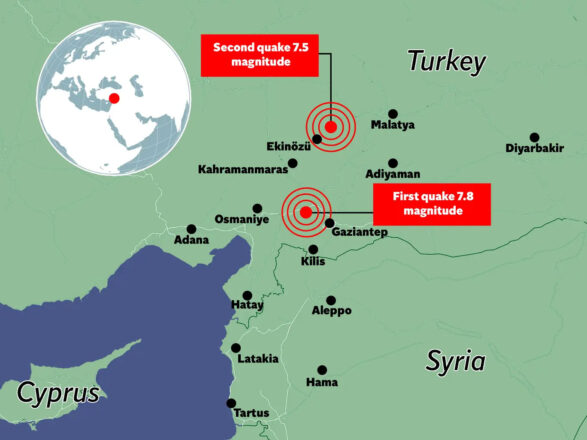In the early hours of 6 February 2023, a powerful 7.8 magnitude earthquake struck southern Turkey near to the northwest Syria border, followed by a second 7.5 magnitude earthquake a few hours later.
Over 50,000 people have been killed and thousands need shelter in what has been described as the worst natural disaster to hit the region in 100 years, according to the World Health Organisation (WHO).
Numerous aftershocks have followed and at least 1.5 million people have been left homeless in the quake zone.

Here’s what you need to know about the Turkey-Syria earthquakes so far:
The earthquakes have affected more than 18 million people
Since the deadly earthquakes hit Turkey and Syria on February 6, at least 18 million people have been affected across the two countries. There has been severe damage to homes, infrastructure, roads and communications.
Thousands require emergency shelter, healthcare, food and water. There has been destruction or damage to more than 214,000 buildings.
The situation remains unstable with two further earthquakes occurring in the region on 20 February and 27 February, followed by multiple aftershocks. These quakes, although less powerful than the first two, have added to the devastation in an area already suffering extensive damage.
Turkey and Syria still need widespread aid
A large scale international response is happening on the ground delivering aid. The United Nations Development Programme (UNDP) estimates that recovery efforts will involve clearing up to 210 millions of tonnes of rubble to make way for the distribution of emergency supplies and rebuilding of homes and livelihoods.
And at least 500,000 housing units need to be constructed to replace the thousands of destroyed buildings.
In addition to those needing shelter, the WHO has sent health supplies to support 400,000 affected by the earthquakes. The WHO regards restoring health services as a priority to avoid a secondary disaster that may impact many more lives.
The World Food Programme (WFP) has also rapidly mobilised, reaching 2.7 million people so far with ready-to-eat rations and hot meals. WFP Executive Director David Beasley has described the situation as ‘apocalyptic‘ saying, “while the world has quickly mobilised in support of people here, the impact of this quake will be felt for months and years to come”.
I’m here in #Turkiye, where @WFP is supporting nearly 1 million people impacted by these devastating earthquakes. Our teams are going all out – from delivering hot meals & family food packages to setting up 500+ mobile kitchens with local partners. More to come! pic.twitter.com/bRwEZ2Xfth
— David Beasley (@WFPChief) February 25, 2023
Thousands of people are homeless in freezing temperatures
The earthquakes have destroyed many homes, leaving thousands needing emergency shelter in Turkey and Syria in sub-zero temperatures. Severe winter storms are sweeping the region, meaning a risk to life for those who have no home to return to.
This is why aid agencies are on the ground supplying tents, blankets and other essential items to support people through the freezing winter months.
The earthquakes have deepened the crisis in Turkey and Syria
Turkey
Before the recent earthquakes hit, Turkey was already in a fragile situation with a spiralling economic crisis. Turkey has just posted a record high current account deficit, with President Erdoğan coming under pressure as a general election looms in May. High cost of living, energy prices and inflation have added to the crisis, with the deficit now at $9.85bn.
Turkey hosts high numbers of Syrian refugees in the area where the earthquakes struck. Syrian refugees are vulnerable due to living with protection risks and economic insecurity. They now face further upheaval and uncertainty.
Concerns have been raised over the large number of newly constructed apartments that have collapsed in the earthquakes in Turkey, compounding the disaster. Previous earthquakes had led to a tightening of building regulations over the past few decades. But there has been poor enforcement of the latest 2018 standards.
Syria
In Syria, there were already 6.8 million people internally displaced in the country before this latest disaster.
Basic services and intermittent electricity have added to the crisis. Over half of Syrians rely on candles to light their homes. And a lack of access to clean water meant a cholera outbreak occurred in September 2022.
After 12 years of conflict, many were living in damaged buildings unable to withstand the earthquakes. Inaccessible roads have further restricted access to badly hit areas.
As many as 5.3 million people affected by the earthquake in Syria may now need some shelter assistance. Aid agencies are supplying tents, blankets, sleeping mats, winter clothing and other essential items in an on-going relief effort.
How can I help?
If you want to help those affected by the earthquakes, you can donate to the Disasters Emergency Committee (DEC) appeal.
DEC is working with local partners to supply emergency shelter, healthcare, food and clean water. Funds will help them scale up their response and reach more people.
Related Posts
August 28, 2020
Brazil: Indigenous Peoples under threat from COVID-19
As concern increases over the threat…
August 12, 2020
Urgent action needed to prevent Covid-19 global ‘catastrophe’: Report
The Covid-19 pandemic has deepened…



